15 Types of emails to use in your marketing
By Kelly Forst June 18, 2024
You’ve heard the advice — send personalized, targeted emails, welcome subscribers to your list, recognize customer milestones and celebrations, and so on.
But did you know there are different types of emails to help you do each of those things?
You don’t have to use all of them, but let this list help you find the best way to reach your audience. Here are 15 types of marketing emails for every purpose.
Overview: 15 types of marketing emails
- 1. Transactional emails
- 2. Welcome emails
- 3. Nurture emails
- 4. Promotional emails
- 5. Digest emails and newsletters
- 6. Re-engagement emails
- 7. Storytelling email
- 8. Targeted emails
- 9. Challenge or course emails
- 10. Cart abandonment emails
- 11. Launch email
- 12. Milestone email
- 13. Survey email
- 14. Privacy policy updates
- 15. Inspiration/educational emails
1. Transactional emails
These emails aim not to market to prospects or customers, but to provide a receipt of an action taken or request submitted.
Examples of transactional emails include order confirmations and receipts, shipping notifications, subscription confirmations, password reset emails, account creation, and more.
But that doesn’t mean transactional emails have to be boring. For example, check out this transactional email from the sneaker company Allbirds. This email infuses the brand’s personality while reminding customers about its animal welfare and sustainability mission.

2. Welcome emails
The purpose of this email is to kick off a strong relationship.
Welcome emails are the first email in a larger campaign. A welcome campaign is a series of automated emails that get delivered to new subscribers over the first few days of their subscription.
These emails should thank readers for joining your list, set expectations around the type of content you will send, deliver your incentive, and send any information they need to know about your or your business.
Bonus points if you reaffirm the value your new subscribers will receive from joining your list or purchasing your product. The mattress company Casper shows us a great example of this.

Related: Welcome email campaigns: How to onboard new subscribers
3. Nurture emails
A nurture email helps a prospect move through the marketing funnel, from initial engagement to conversion.
Nurture emails are automated and generally tied to a lead magnet — something you give to people when they subscribe to your email list. These types of emails include targeted content based on the lead magnet they downloaded. The goal is to encourage prospects to convert to customers.
Nurture emails should include valuable content or exclusive offers like discounts.
Related: Email automation for beginners: See how to get better results in less time
4. Promotional emails
Promotional emails are one-off emails or broadcasts sent to an audience of prospects or previous customers. These types of marketing emails aim to promote a product, service, or limited-time sale. It makes it easy to convert subscribers to customers.
Promotional emails can also invite subscribers to an event or webinar.
Check out this promotional email from Freshly, promoting their End of Summer sale. They did a great job showcasing how much money customers save up to their fourth order.
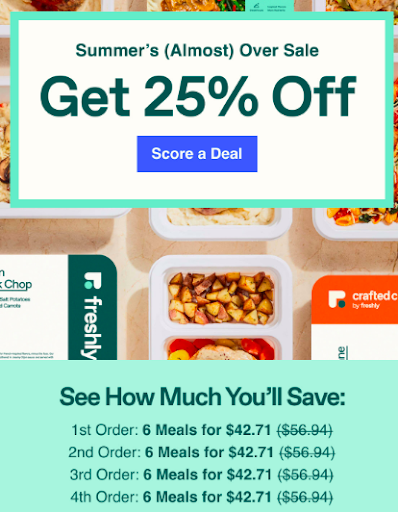
5. Digest emails and newsletters
Newsletters are a type of email that any business, including creators, bloggers, small business owners, and more, sends subscribers regularly.
Newsletters can include company updates, new blog posts or podcast episodes, relevant articles, or curated news from reputable sources. They can help you establish thought leadership and build a relationship with subscribers with valuable content.
Plus, if you have a blog or a podcast, you may have an RSS feed. With a tool like AWeber, you can automatically put your content in an email without replicating your efforts.
Watch how:
Here’s an example of AWeber’s customer newsletter. Each week we send high-value content, our most recent three blog articles, bonus tips, and more.

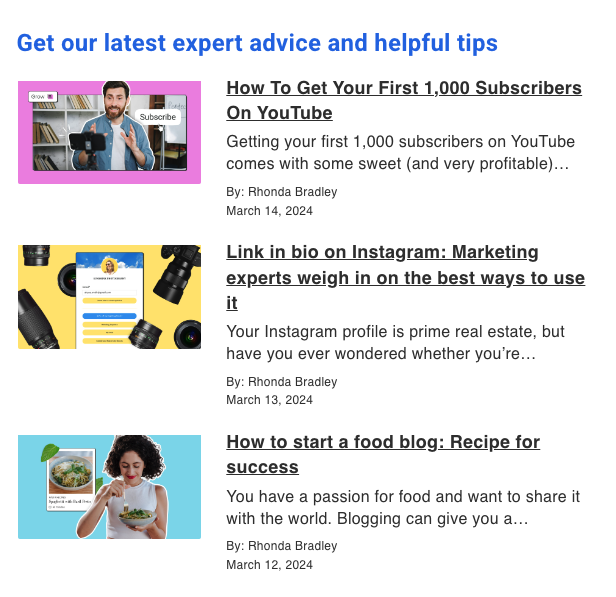
6. Re-engagement emails
Sometimes, subscribers stop opening and reading your emails. That’s okay — it happens to everyone.
But that doesn’t mean that those subscribers are a lost cause. Re-engagement emails can help you remind your inactive subscribers about the value that you offer them.
Restaurant reservation app Resy sent their inactive subscribers an email reminding them how to use the app to find restaurants to dine at.

Pro tip: Are subscribers still not engaging with your messages after sending a re-engagement email? It may be time to unsubscribe them from your list.
This is a good thing for your email marketing. Unloading inactive subscribers increases your open rate. When inactive people who wouldn’t open the message regardless aren’t skewing the rate, it makes it easier to tell when your content does (or doesn’t) resonate with your active audience.
7. Storytelling email
Storytelling emails are one of the more interesting types of marketing emails. The goals of many emails thus far have been to drive sales or re-engagement. These emails help build your brand story and build deeper relationships with your subscribers.
Stories help people connect. They build emotional connections and let readers relate to you. Author and entrepreneur Ramit Sethi frequently incorporates stories into his daily emails — both his own stories and those of his successful customers.
Check it out:
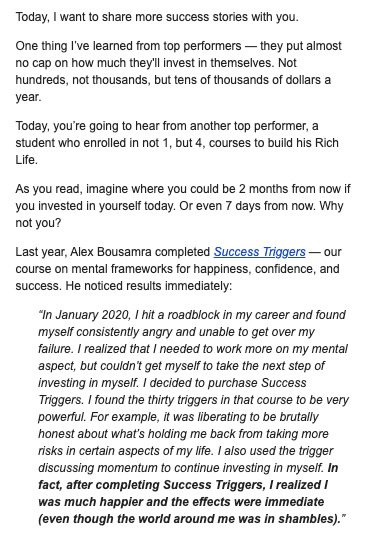
8. Targeted emails
Targeted emails involve segmentation — breaking your subscriber list into categories. You can segment based on demographics, prior purchases, interests, or recent engagement with your emails.
For instance, if you sell apparel, you can send a targeted email promoting a sale on hats to a segment of customers who recently purchased a hat.
Related: Email tags for marketing 101: Understanding tagging and segmentation
9. Challenge or course emails
Email challenges and email courses can be a lead magnet or even a paid digital product. The idea is to deliver a lesson daily, weekly, or monthly.
See below for a campaign template you can upload to your AWeber account. Use it as a starting point for your own email course.
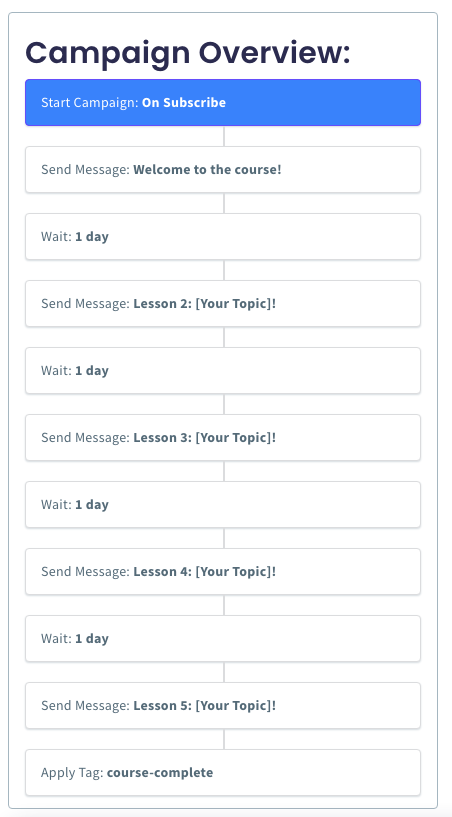
10. Cart abandonment emails
Have you ever added something to your shopping cart and then not followed through on a purchase? That’s called cart abandonment. And smart email marketers send cart abandonment emails to remind their customers that they left something behind.
Cart abandonment emails optimize sales. Take abandoned cart emails to the next level by offering a discount on the product that your subscriber was looking at. That can lower the barrier to purchase and your subscriber will likely feel good about your brand after receiving that kind of personalized offer.
See how Food52 called attention to a subscriber’s abandoned cart in this email.
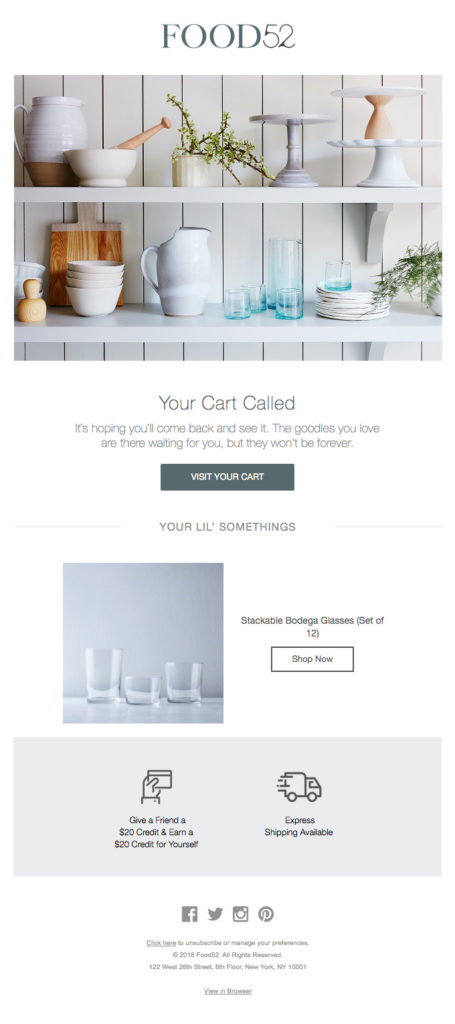
11. Launch email
These types of emails are used for a very specific purpose: to announce a new product, service, or feature.
Launch emails are one of the best ways to let interested subscribers know about things that could help them achieve their goals. Plus, tease your launch ahead of time on your website or landing page and let visitors sign up for early updates.
12. Milestone email
Celebrate your subscribers’ successes, birthdays, and anniversaries with a milestone email. This type of email builds brand affinity by recognizing customer loyalty and major accomplishments.
For instance, at AWeber, we like to recognize our customers’ subscriber growth. We know it takes a lot of hard work to build your subscriber base and want to help our customers celebrate those milestones.
To do that, we send milestone badges that customers can share on their social media profiles.

13. Survey email
Survey emails can offer insight so you can create content that resonates with your subscribers. Gathering feedback via a survey email is also one of the best ways to round up testimonials to use as social proof.
See how Ritual uses a survey email to ask subscribers to fill out a short survey.

14. Privacy policy updates
Emailing subscribers about updates to your privacy policy may not seem important to your marketing strategy. However, transparency and data protection are a huge priority for many conscientious consumers.
Even if you are not legally required to do so, these updates strengthen trust in your brand. Just keep it direct and informative. Unlike transactional emails, where you can assert brand identity, these are strictly business.
15. Inspiration/educational emails
Inspire or show customers new ways to enjoy your product or service. These types of emails offer free tips and ideas in one message.
For example, if you sell jewelry or apparel, put together a quick style guide for the season. It can work with almost anything you offer as long as you are showing readers how to get the benefit you’re showcasing.
Are you leveraging different types of emails?
No matter what types of emails you send, they help you accomplish your goals. Try a few different types of emails this month and watch as your audience falls into place.
Ready to start sending with AWeber? Get AWeber for free today!

